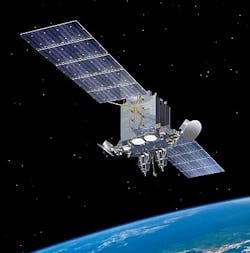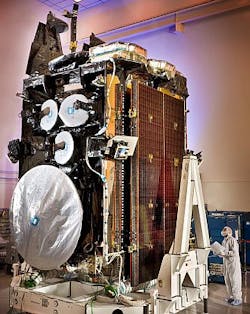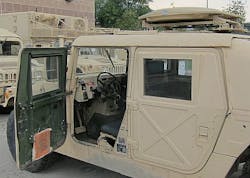Satellite communications becoming small, mobile, and available to warfighters on the front lines
SPECIAL REPORT, 31 July 2012. Information is king on the battlefield; hundreds or thousands of warfighters need to know the positions and capabilities of everyone involved. The problem is the unreliability of communications channels, which can lack sufficient bandwidth or require certain circumstances such as line-of-sight. Satellite communications (SATCOM) aim to end these communication woes by offering fast, reliable communications that are difficult to intercept or jam.
In the past, satellite communication was only possible with large dish antennas, making it difficult for soldiers on the front lines or on the move to have access to SATCOM. Traditional radios were used rather than carrying a terminal complete with a satellite dish or antenna towards the front lines. Now, satellite communications can come in man-packable systems that weigh less than ten pounds. Since satellites are becoming more accessible, there has been a heavy push towards new satellite technology (story continues below).
Space technology itself has been improving at a rapid pace, with new satellites featuring the latest hardware being launched into space frequently. Aging satellite constellations, such as the U.S. Navy’s ultra-high frequency (UHF) satellite system, have been being upgraded or replaced with superior technology. These new systems offer bandwidths that can support applications that require high volumes of data such as streaming live video to many simultaneous users.
Full data access
Satellites provide warfighters with a way to access data that is not readily available with line-of-sight communications and traditional land-based systems. "It's no longer a linear battlefield,” explains Ross Osborne, senior manager of business development for GNOMAD, a mobile satellite communication terminal at ITT Exelis in McLean, Va., "You have small platoons that need the type of information that brigades use."
Battlefields have become even more chaotic, and each soldier needs to know what lies beyond the next hill, where friendlies are located, and have a reliable line of communication that provides data as well as voice communication.
Thanks to satellite communications, soldiers and Marines on the front lines can access information that previously was available only to high-echelon commanders far from the battle. Satellites are connected potentially to the entire military network, so any warfighter who can communicate with a satellite has access to all the information he needs. This enables better situational awareness and decision making across the board.
Communicating with lasers
Lasers enable communication not only among different satellites in space, but also for terrestrial-to-satellite communications. Using a laser terminal to communicate with a satellite provides higher speeds, larger bandwidth, greater security than communicating using radio waves, but it carries several restrictions as well.
Lasers require a direct line of sight to communicate with any satellite, while radio waves can pass through many barriers that are impossible for lasers to penetrate. Due to the unreliability lasers have in combat zones or adverse weather conditions, SATCOM near the front lines typically are carried out exclusively using radio waves rather than lasers. Outside of the battlefield lasers communicate with satellites for high bandwidth applications, such as downloading images.
Man-packable SATCOM
Systems designers at the ITT Exelis capitalize on the Iridium commercial satellite constellation operating in low-Earth orbit for the company's new hand-held satellite radio system. The RO tactical radio enables users to communicate in classic push-to-talk fashion with anyone in range of the satellite they are using, a range of 200 to 500 miles. The system also enables warfighters to share situational awareness data.
One of the major features of the Iridium constellation and the RO tactical radio is that the satellites will ‘hand off’ communications as satellites leave the handheld’s range due to the Earth’s rotation or their own rapid orbit. Rather than breaking the communication off, a nearby satellite is contacted and tasked with keeping communications active. As there is always an Iridium satellite nearby, this provides constant connectivity in a large area that other forms of communication don’t offer.
SATCOM terminals
Much of satellite communication is done through the use of a terminal that is placed into a vehicle. These terminals give the area they are in a network that enables soldiers to access the satellite communication network while serving as a central hub for communication in the area. These terminals often use phased array antennas, which can communicate with satellites, along with line-of-sight devices such as radios.
Problems with SATCOM
While satellite communications confer many benefits to its users, it does have a few noticeable drawbacks. One issue in particular is the latency involved due to the sheer distance the communications need to travel. With radio frequencies the latency can be hundreds of milliseconds, a time that isn’t insignificant when information can be the difference between life and death. The latency is decreased greatly when using lasers, but due to their unreliability lasers are not regularly used at this point.
Satellite communications also require access to the sky, or at least the ability to send radio waves or light into space. This can lead to issues where geography can limit connectivity or even completely cut communications, particularly in communications with satellites in geosynchronous orbit. It is not uncommon for certain areas to be dead zones for SATCOM, though new satellites being launched are helping to solve this problem.
The other problem is that communicating using radio frequencies, the most common way to communicate with satellites from the ground, can be intercepted or jammed by enemies. This problem is especially large with SATCOM that have to travel such as a long distance, creating a larger window for jamming and interception opportunities.
To avoid jamming, SATCOM and satellite communication terminals have the ability to hop frequencies, skipping through different frequencies until they find a clear channel to send and receive information on.
The future of SATCOM
New satellite programs have been cropping up much more frequently as of late, with massive projects such as GPS III, MUOS and Iridium NEXT moving forward. As satellite communication becomes a more important tool in the battlefield, and in everyday life, the industry is advancing new programs with improved technology.
Advancements for satellite communications will be focused on higher bandwidth and reduced latency, says ITT Exelis’s Osborne. He also sees major improvements coming for terminals on the ground, “I think terminal sizes are going to continue to reduce,” he says, “I think satellite technology will be able to provide a very low-cost small terminal.”
The future will not only hold superior electronics, but it will include new frequencies for RF communication with satellites as well. “For RF communication payloads we're seeing transitions to higher and higher frequencies,” says Ken O-Neill, director of marketing for space products at Microsemi Corp. in San Jose, Calif. “You're seeing more satellites with Ka-band transponders. It provides more communication channels. You want to maximize the number of channels for satellite, in the world of military communications it allows you to do higher resolution video and more channels of video."
The improvements coming to SATCOM are, to Ken, a natural part of the business. “It's been a continuous evolution,” he says. The satellite communication technology we have today is leaps and bounds ahead of the technology we had in the previous decade, and, with a large push for faster and more efficient satellite communication coming from the entertainment and communication industry, there is no lack of funding going into the development of superior SATCOM.





